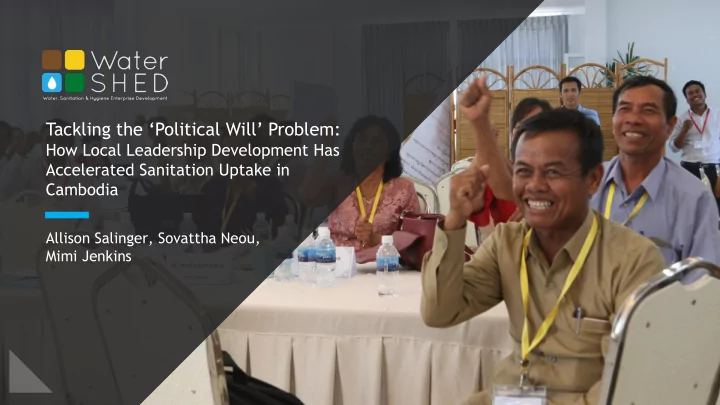

1 Tackling the ‘Political Will’ Problem: How Local Leadership Development Has Accelerated Sanitation Uptake in Cambodia Allison Salinger, Sovattha Neou, Mimi Jenkins
Introduction: Program Background The Civic Champions program: • Develops general leadership skills, experience, and confidence of local-level, elected government officials • Uses sanitation as a leadership practice problem Key program design elements: • Application and participation fee • Cascade facilitation model • Teamwork - councilors from the same commune work together, assigned target based on team size • Cyclical training with award mechanism for peer recognition
Introduction: Objectives of the Evaluation This evaluation seeks to : Table 1. Evolution of the Civic Champions program 1. Determine the extent to which the Civic Pilot Scale-up ‘Light’ Hybrid Champions program affects latrine sales during Year(s) of Q4, 2013 - Q3, 2015 - Q1-Q2, Q3, 2018- program implementation periods implementation Q3, 2014 Q2, 2016 2017 Q2, 2019 # of 2. Determine whether there is a sustained effect on participating 2 16 30 18 latrine sales after the program implementation districts period # of participating 22 105 204 143 communes 3. Identify program and contextual factors that may # of influence achievement of commune teams in terms 54 204 375 263 participants of the number of new, pour-flush latrines installed in the commune during the course of implementation
5 Methodology Latrine Supplier Data Collection: Latrine Sales Government-Led Data Collection: Latrine Uptake District Focal Person Commune-level data Village and commune-level Purchase data data Commune Focal Person WaterSHED-facilitated HH-level data Latrine Suppliers Village Focal Person
Latrine Sales
Comparing Latrine Sale Patterns Figure 1. Quarterly latrine sales (2012-2018), by Civic Champions program iteration 50.0 Civic Pilot (n=22) 45.0 Scale-up (n=86) Average quarterly latrine sales per commune Light (n=138) 40.0 Never Civic (n=527) 35.0 30.0 25.0 20.0 15.0 10.0 5.0 0.0 Q1 Q2 Q3 Q4 Q1 Q2 Q3 Q4 Q1 Q2 Q3 Q4 Q1 Q2 Q3 Q4 Q1 Q2 Q3 Q4 Q1 Q2 Q3 Q4 Q1 Q2 Q3 Q4 2012 2012 2012 2012 2013 2013 2013 2013 2014 2014 2014 2014 2015 2015 2015 2015 2016 2016 2016 2016 2017 2017 2017 2017 2018 2018 2018 2018 Calendar year quarters
Comparing Annual Growth in Latrine Sales Table 1. Difference in sales growth, by Civic Champions iteration Percentage Point (pp) Difference in Year-over- Total Annual Latrine Sales (Count) Year Sales Growth Program Commune Intervention Status Iteration (at the time of each iteration) Prior Year Implementation Year Post Year Implementation vs. Prior Year Post vs. Prior Year Intervention (N = 22) 593 1,710 1,202 Pilot 142 pp 75 pp (Q4, 2013 – (188% vs. 47%) (103% vs. 28%) Q3, 2014) Comparison (N = 516) 20,432 29,991 26,190 Intervention (N = 88 ) 6,941 8,570 6,308 Scale-Up 32 pp 22 pp (Q3, 2015 – (23% vs. -9%) (-8% vs. -29%) Q2, 2016) Comparison (N = 455) 18,883 17,196 13,372 Intervention (N = 139) 3,831 4,155 2,104 Light* 34 pp 18 pp (Q1-Q2, (8% vs. -25%) (-45% vs. -63%) 2017) Comparison (N = 405) 10,166 7,600 3,793 * For “Light” iteration, total latrine sales include only Q1 -Q2 sales for Prior Year (2016), Implementation Year (2017), and Post Year (2018)
Latrine Uptake
What influences achievement? Factors hypothesized to influence or account for some variation in total latrines achieved: Program factors Contextual factors • Team size • HHs without latrine in the commune • • Latrine increase target Proximity and number of latrine suppliers • Challenging environments/topography • Mixed gender vs. single gender teams • ID Poor households (i.e. poverty) • Presence of other programs in the area • Population density
Latrines Achieved: Civic Champions Scale-Up Table 3. Linear regression model for number of new pour-flush latrines installed only in communes (N = 105) participating in Civic Champions Scale-Up 95% C.I. Covariate of Interest β SE β t p Lower Upper Constant 83.119 42.865 1.939 0.055 -1.924 168.163 On average, communes # of ID Poor HHs in commune -0.148 0.063 -2.341 0.021 -0.273 -0.023 in the Scale-Up iteration achieved 181 new pour- Latrine target 0.264 0.128 2.066 0.041 0.010 0.517 flush latrines installed over the course of the # of HHs w/o latrine at BL in 0.119 0.071 0.024 2.953 0.004 0.023 commune 10-month program. Gender interaction (mixed vs -0.087 0.079 -1.092 0.277 -0.244 0.071 single gender teams * target) Adjusted R Model evaluation F d.f. p square 0.089 3.542 4 0.010
21 Key Takeaways Impact of program – Increased rate of growth in latrine sales both during and after implementation Importance of targets – Assignment of a higher quantitative target led to significantly higher achievement by the commune Gender effects – There may be obstacles to achievement associated with mixed gender teams
22 Next Steps - Current “Hybrid” Iteration (2018-2019) - Institutionalizing Civic Champions Program: - Provincial Government : Government-led model - Research: - National Government : Government-led model - Distill core factors of Civic Champions [Leadership Training by Ministry of Interior] Program - Utilize research as evidence when working with governments
23 Thank You
Recommend
More recommend